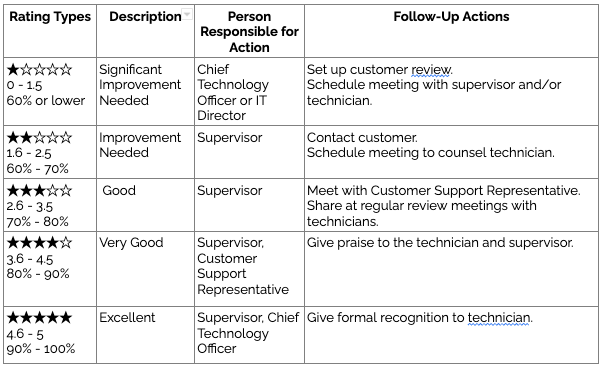4.1 Ensure Customer Satisfaction
Basics
Customer service is not just a department. Everyone in the IT Department works with customers--whether they are internal or external to the Department--and customer satisfaction is a prime goal for everyone in the department. You can collect data to measure how satisfied or dissatisfied customers are with their experience with your department by capturing their perceptions about the quality and value of the service they received compared to their expectations. Just like you, they want their technology to work, and when it doesn’t, they want things resolved as quickly and effectively as possible.
Terms to Know
You should know the following terms:
- Customer satisfaction
- Continuous improvement
- Root-cause analysis
Information
Every IT Department should collect some type of feedback from the customers they interact with. Your department may use one or more strategies to measure customer satisfaction. You can ask customers to complete surveys following a service, either by phone, email, or embedded in the online ITSM system. You’ve probably received some of these yourself if you’ve ever had to contact customer service for a product or service you own.
Technicians or customer service representatives may be asked to personally call or email customers with whom they’ve worked and ask them scripted questions about their level of satisfaction. Some Help Ticket systems also allow customers to rate the service they received when it is closed.
Some of the types of satisfaction data that may be collected are:
- How satisfied is the customer with the specific resolution to the Help Ticket?
- How satisfied is the customer with the level of service provided by the technician or customer service representative? Was the technician or customer service representative friendly, polite, helpful, attentive, prompt, and reasonable?
- How satisfied is the customer with the ITMS system? Was it easy to use? Did it provide the type of support they needed?
- How satisfied is the customer with the overall experience interacting with the IT Department?
Reviewing Customer Feedback
Time should be allotted to periodically review the feedback that has been collected across the department, at least once or twice a year. A good ITSM system can help aggregate the data and run reports.
Presenting customer feedback data by department and even by employee can be important for performance reviews and to help the staff understand how well they are doing on performance goals. Ratings can suggest improvement plan follow-up actions--for departments or individuals, and can be an important aspect of continuous improvement of the entire department. High ratings can also result in celebrations or accommodations for staff members and can provide evidence that past improvement efforts are paying off.
Collecting customer service data should be deliberate, systematic, and consistent. All staff are responsible for collecting data relevant to their work or the work of their department. A lack of data can skew performance. Consider the following ways your Department can collect customer satisfaction data.
Request feedback from customers.
As noted, you may incorporate a feedback survey into all service requests. These can be asked by phone, email, or through an online form. If your ITSM system does not support this type of data, be sure all staff have access to easily record the feedback they receive into some type of log. You may also want to support less formal interactions in your log, such as conversations with customers made individually or during group settings.
Establish a consistent review process.
Who will review customer service feedback and when? If you have a system that makes it easy to collect and aggregate, supervising staff can be assigned to review the feedback daily or weekly. High priority tasks may be reviewed more often, if deemed necessary. Consider scheduling consistent periods for feedback review and reporting back to relevant staff. If you collect the data, it should be used. If it’s not helpful, stop collecting it.
Create a customer satisfaction rating level.
Rating levels should be easy to use and relevant. They might be automated. Not all satisfaction rating systems are the same, but a graphic that shows a sample of ratings and the actions they might generate is given below:

Conduct root-cause analysis.
Patterns in the feedback may indicate issues are worthy of further review. Investigate thoroughly to dig beneath the surface of a problem and understand why the problem occurred in the first place. These findings are often the greatest source of learning and can yield improvements in the processes you use and the performance of staff members.
Communicate your efforts to your customers.
Even minor adjustments can be perceived as major improvements by your customers. The fact that you’ve taken the time to receive feedback and act on it can show you are being empathetic to their needs. This will build trust with the people you work with and increase your department’s social capital, which can come in handy in the long run if you have significant asks or requests from those you work with.
Additional Resources
Here are additional resources you may find useful:
- Customer Satisfaction Surveys: A Comprehensive Guide is an article with 10 tips and examples in different formats by Kiera Abbamonte for HelpScout
- How to Create Effective Customer Satisfaction Surveys includes general guidance from a survey tool creator, VerticalResponse.
Task/Self-Assessment
Complete the following task or self-assessment:
-
What kind of customer satisfaction feedback does your department collect?
-
How is it captured, organized, and reported?
-
What are the obligations for entry-level technicians or customer-service representatives to seek customer satisfaction feedback?
-
-
How often will customer satisfaction feedback be reviewed and shared with staff, either at the department or individual level?
-
Does your department have a clear hierarchy of follow-up actions based on customer satisfaction feedback data?
